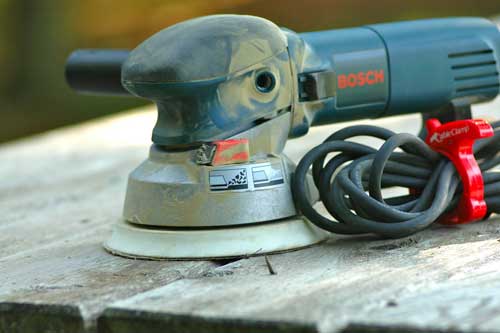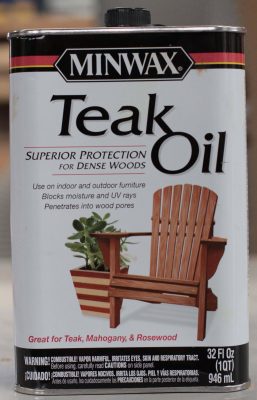 Exterior wood is risky stuff. Everyone’s happy with the look of it at first when lumber is new, but as aging sets in, things often get ugly. This is especially true if the wood’s been coated in a film-forming finish because sooner or later these always peel. Sanding and scraping are required to get back to square one, and this is usually a job that’s way worse than finish reapplication. All this is why you might want to think about exterior oil finishes.
Exterior wood is risky stuff. Everyone’s happy with the look of it at first when lumber is new, but as aging sets in, things often get ugly. This is especially true if the wood’s been coated in a film-forming finish because sooner or later these always peel. Sanding and scraping are required to get back to square one, and this is usually a job that’s way worse than finish reapplication. All this is why you might want to think about exterior oil finishes.
This little-known approach for finishing outdoor wood is faster than anything else, moderately protective and super easy. It works just as well on new wood as it does on old. It also creates a fresh, rich look, with no possibility of peeling or ongoing maintenance dependency. Exterior oil is not for every situation and every person, but it is definitely worth considering.
If You Have to Sand . . .
 Speed and ease of application (and especially re-application) are the main advantages of oiling exterior wood. Brush it on and that’s it. You may have to start with sanding if you’re dealing with a grey, weathered, dirty surface, but only if the surface is fuzzy and cracked. If you do have to sand, choose a 6-inch random orbit sander rather than the more common 5-inch sanders. The bigger tool is MUCH faster. You’ll find 80-grit sanding disks work best for preparing outdoor wood. There’s no need for anything finer.
Speed and ease of application (and especially re-application) are the main advantages of oiling exterior wood. Brush it on and that’s it. You may have to start with sanding if you’re dealing with a grey, weathered, dirty surface, but only if the surface is fuzzy and cracked. If you do have to sand, choose a 6-inch random orbit sander rather than the more common 5-inch sanders. The bigger tool is MUCH faster. You’ll find 80-grit sanding disks work best for preparing outdoor wood. There’s no need for anything finer.
Minimal-Prep Refinishing
The good news about sanding is that you won’t have to sand much in the future (or any at all) if you go with exterior oil. Although oil isn’t used very often for outdoor wood, it’s the best choice for a casual-but-cared-for look. It enhances the appearance of old wood and new, and as I said it never peels. Maintenance is just a matter of applying more oil. Don’t feel like keeping up with the oiling regime? No problem. Leave the wood alone and it simply resumes weathering as the oil wears out. No peeling, no worse-than-before mess. Oiling is especially good for outdoor wood furniture, since all the nooks, crannies and spaces between slats, legs and arms are almost impossible to strip properly when paint or varnish peels.
Brush or Spray Application
 A few years back a couple of my boys and I joined a volunteer work crew sprucing up a 20-year-old wooden play structure, and we used a combination of sanding and Minwax Teak Oil to rejuvenate the surfaces. Although this product isn’t specifically rated for decks, it proved easy to use and effective, even on the horizontal, deck-like floor surfaces of the structure. I’m sure there are other good exterior oils out there, but this one is the best I’ve tried so far.
A few years back a couple of my boys and I joined a volunteer work crew sprucing up a 20-year-old wooden play structure, and we used a combination of sanding and Minwax Teak Oil to rejuvenate the surfaces. Although this product isn’t specifically rated for decks, it proved easy to use and effective, even on the horizontal, deck-like floor surfaces of the structure. I’m sure there are other good exterior oils out there, but this one is the best I’ve tried so far.
We did our application mostly with a brush, though spray equipment was also used on larger areas of the project. Since the oil soaks in quickly, there’s never any worries about drips or runs. You’ll find that exterior oils like this continue looking good for about a year. The real advantage is that renewal is simply a matter of putting on more oil, with no need for sanding first.
What’s the Catch?
No exterior wood finish is perfect, and that goes for exterior oil. Although re-application is easy (and that’s a huge plus), exterior oil doesn’t do much to prevent dirt from getting ground into wood surfaces from foot traffic. It also requires annual reapplication. Exterior oil doesn’t impart much colour to the wood and it can’t hide areas that have gone grey and discoloured.
As I mentioned before, one of the best uses for exterior oil is outdoor wood furniture. In fact, it’s one of the only finishing options that won’t leave you grieved. Paint and film-forming stains look great at first, but in a year or two you have an ugly mess, with peeling happening in all those inaccessible nooks and crannies of your bench, table, chairs or whatever.
Exterior wood regularly disappoints people because the hidden workload of finishing and refinishing with paint or varnish is massive. I’ve yet to see anything better than simple, reliable and under-appreciated oiling for certain applications. It certainly deserves to be better known.